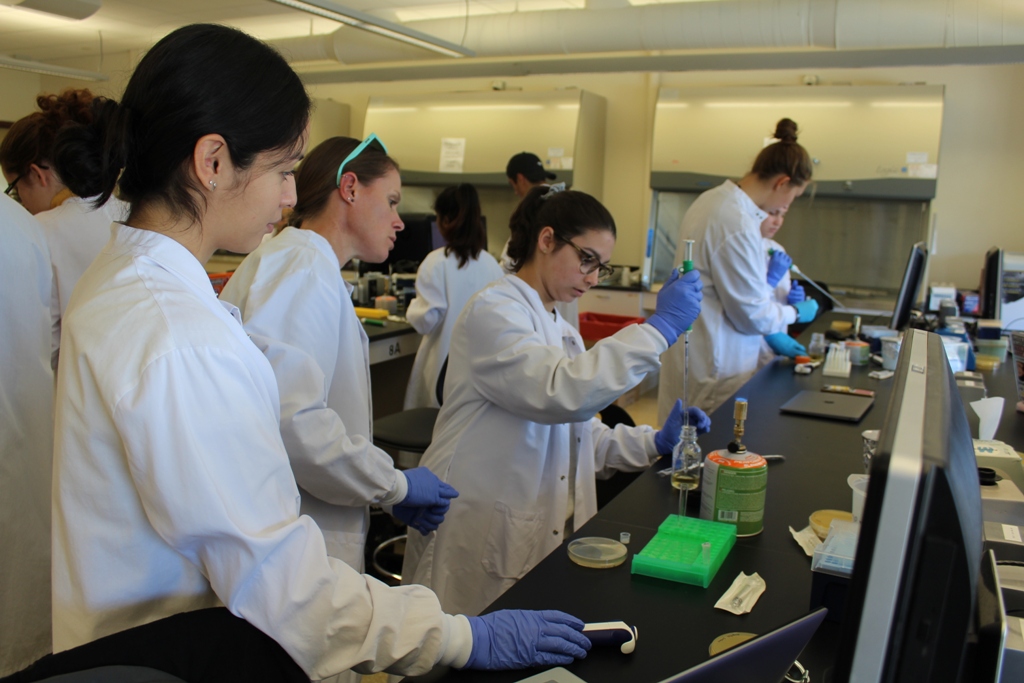Dirt to DNA: SEA-PHAGES Project Gives Freshmen Unique Research Opportunity

Twenty freshmen biology and bio/medical science majors are embarking on research that may eventually lead to the discovery of viruses that treat antibiotic-resistant bacterial infections.
SUNY Plattsburgh is one of only 177 colleges and universities nationwide to be selected to participate in the Science Education Alliance-Phage Hunters Advancing Genomics and Evolutional Science, or SEA-PHAGES Program, sponsored by the Howard Hughes Medical Institute. Of the 177, only 50 have classes running this semester, and only five of those are in New York. Plattsburgh and Old Westbury are the only four-year SUNY schools in the mix.
According to Dr. Nancy Elwess, distinguished teaching professor of biology, the project is a national research-based laboratory course aimed at early career science students.
Hands-on Undergraduate Research
“It’s a very hands-on, pure research-based application for freshmen,” she said. “Phage is a virus, and these students in Bio 101 will be phage hunters, from dirt to DNA.”
The two-semester program began this semester with students who were hand-picked based on their academic achievements entering the freshmen class, said Dr. Amy Ryan, assistant professor of biology and one of two teaching the course during the fall. Her counterpart this semester is Dr. Megan Valentine, lecturer in biology. Elwess and Dr. Alyssa Gleichsner, assistant professor, biology, will teach the second part of the course in the spring.
“The students had to be biology or bio/medical science majors who were at the top of their class,” Ryan said. “Of the 24 invited, 20 chose to participate.”
Students were off and running the first week of classes, sent to collect soil samples from various sites on campus and off.
“Each student has to have his or her own samples,” Elwess said. From the samples, students will isolate the DNA and characterize any phages. Students meet in the lab in Hudson Hall twice a week, two hours each day. “It is a true, authentic research experience. When they are through in December, they will continue on in the spring meeting twice a week as a lab. They will analyze their data and hopefully, we’ll come up with new viruses that we’ll name.”
Findings Compiled for Database
That data will be sent to a database at the University of Pittsburgh where it may some day be used to treat bacterial infections that are not responding to conventional antibiotic treatment.
“If we understand phage biology, we might better understand phages as a whole,” Ryan said. “Phage therapy has already been useful in treating antibiotic-resistant bacteria.”
“It’s impossible to know when one will be found and be medically useful. One treatment used on an individual was from a phage a student found in the SEA-PHAGE program,” Valentine said. “That’s why it’s important to have this project. Researchers will go through everything they’ve got to find something that works.”
Ryan said SUNY Plattsburgh is in a unique position to be participating in this project.
“There are no schools in this part of the country participating — there’s nothing in Vermont, nothing in this swath of the region. No one is looking but us.”
Collaborative Effort
Truly a collaborative effort, Gleichsner initially found out about the project, “and we all worked on the grant,” Valentine said. “It’s a natural division of labor — Nancy and Alyssa are more bioinformatics, computer based, and Amy and I are more field- and lab research-based. It’s very exciting.”
Freshman Jordan Krinsky of Carmel, N.Y., thinks so.
“It’s cool to be involved in a research project like this,” she said. “It’s a good environment to be in. The teachers, other students and teaching assistants are all very helpful.”
Allison LaPointe of Champlain, said she was grateful for the opportunity.
“I’m so glad Dr. Ryan chose me as one of the students to be involved. Hopefully, we’ll be able to help a lot of people,” she said. “I’m hoping we can find some sort of phage and have a better understanding of microbiology and how it works in terms of medicine.”
Valentine said the hope is for two students to present at the annual Science Education Alliance symposium, which brings together SEA-PHAGES students and faculty members from around the country to connect and share their research.
Ryan said they hope to build on the students’ experiences in the second year.
“This is a unique experience and a great opportunity for us and our students,” Elwess said.
News
SUNY Plattsburgh, NCCC Announce New Admissions Initiative

SUNY Adirondack Students Benefit from New Dual Agreement with SUNY Plattsburgh Queensbury
